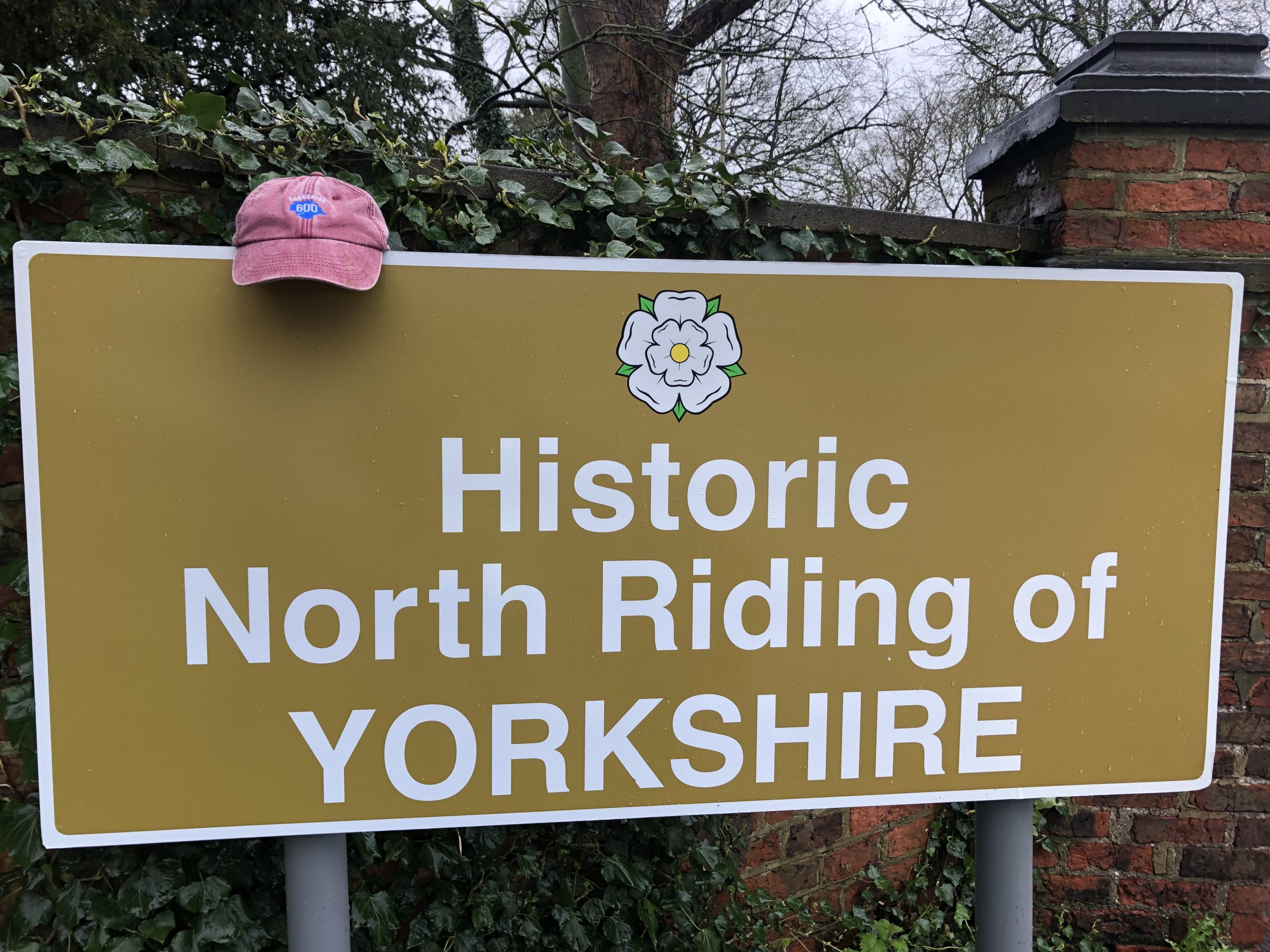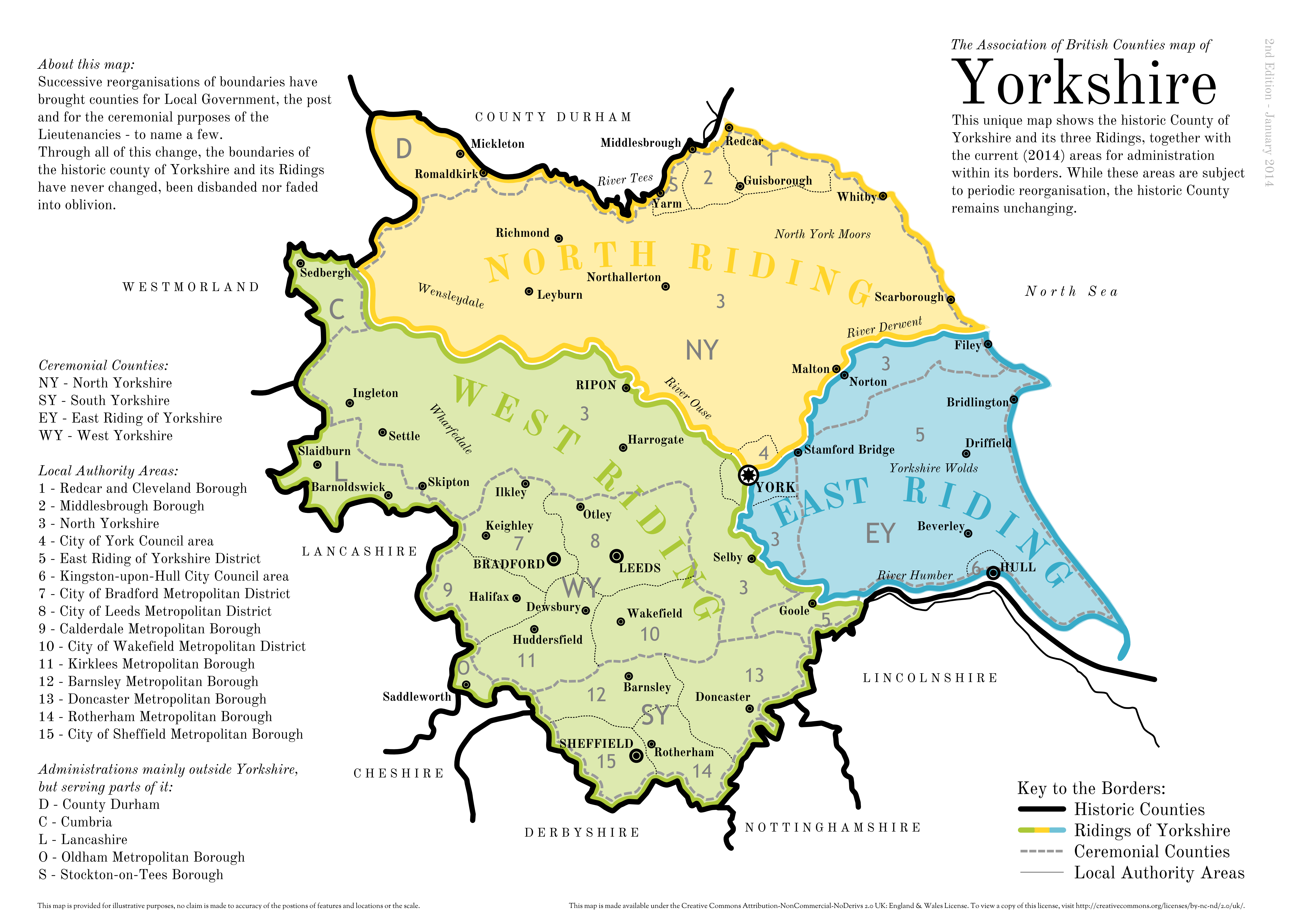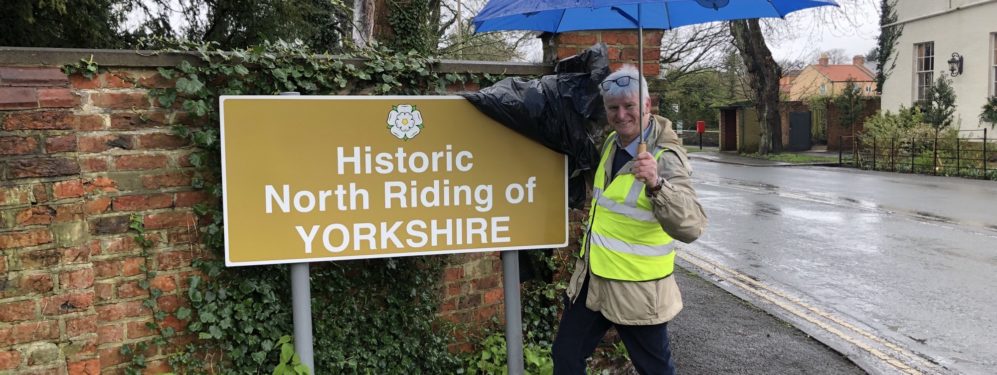On the fiftieth anniversary of the infamous 1974 local government changes, the Yorkshire Ridings Society and the Historic Counties Trust have unveiled the first of a set of new road-signs marking the border of Yorkshire and the borders of its ridings.
The first “Historic North Riding of Yorkshire” sign was unveiled at 10.00am on 1st April 2024 in Croft, where the A167 crosses the River Tees from County Durham into Yorkshire. It is the first sign in a scheme to fully mark the borders of the ridings of Yorkshire, and the border of Yorkshire itself, on major routeways. Funds have been raised and plans are in place to pursue a roll-out of these signs over the next 12 months.

Nigel Wilkin (pictured above unveiling the sign) of the Yorkshire Ridings Society said,
“1st April 2024 marks 50 years to the day since the enactment of the Local Government Act 1972, which was intended only to change the pattern of local government in England and Wales. As a result of this Act, the Ridings County Councils were abolished along with many other local authorities across the country. However, this Local Government Act 50 years ago only changed the pattern of local government. It did not alter counties as cultural, geographic and historic places. The ridings of Yorkshire as places with a long, (1000+) year history continue to exist to this day.
The purpose of these new signs is to officially mark the border of Yorkshire and the ridings’ borders within it, to remind people of their identity as Yorkshire people and to show that historic counties continue to exist, alongside units of local government.”
The Yorkshire Ridings Society and the Historic Counties Trust wish to acknowledge and express their gratitude to North Yorkshire Council for its co-operation, significant help and support in order to make this project possible. The cost of the sign was met entirely by donation with no cost to public finances.
Peter Boyce of the Association of British Counties (ABC) said,
“One of the disastrous consequences of the 1974 local government changes, and the geographical confusion they unleased, was that many of the road signs which marked our historic counties were unceremoniously taken down and replaced by signs marking the then new local government areas. We are determined to see a full replacements of appropriate signage of the historic county borders, not just on roads, but footpaths, bridleways, canal paths and so on.
We are delighted that the Historic Counties Trust, ABC’s charity arm, has been asked by the Yorkshire Ridings Society to be part of the scheme to see a full restoration of signs marking the border of Yorkshire and of its ridings. It is great to have North Yorkshire Council’s support in this scheme. We will be seeking to work with other local authorities in Yorkshire to ensure that the county and riding borders are marked throughout Yorkshire. We will, of course, continue to seek the erection of historic county signs throughout the whole UK.”

Since 2015, following lobbying by ABC, the Government’s Traffic Signs Regulations and General Directions have permitted the erection of signs on highways marking the borders of the historic counties throughout the UK. Since then, a growing number of such signs have been erected.

Peter Boyce continued,
“We are keen to work with local authorities, local groups and interested local people to see historic county border signs erected throughout the UK. In general such signs need to be funded by public donation. Any donations made to the Historic Counties Trust’s Border Signs Appeal will be used towards marking the borders of our historic counties and their traditional divisions throughout the UK.”


27 thoughts on “Yorkshire Ridings: Road-sign Rollout Begins”
Keep up the great work !
A belated Happy Cheshire Day (30th March) to you all
Thanks !
Fantastic News! As a regular traveller from Leeds, West Riding of Yorkshire, to Glasgow via the A66, Scotch Corner to Penrith, I always curse when passing Stainmore Summit, when I see the Cumbria sign westbound & the County Durham sign eastbound. Hopefully, this won’t be for much longer. I would also like to see a new Cumberland sign at Brougham, at the River Eamont crossing, which is the traditional Westmorland/Cumberland boundary. Your longlasting campaign is really gaining momentum, appropriately on the fiftieth anniversary of the 1974 Local Government Act. I am happy to have made a donation to the cause & all good luck for future progress.
Many thanks for your kind comments and your donation. The borders crossings you mention are on our list of desirables. Because North Yorkshire Council are behind marking the ridings, initially we’ll be focussing on getting up signs in this council area. But we’ll also be seeking the cooperation of other local authorities.
Thanks for you speedy reply.
Whilst I imagine that North Yorkshire Council would be OK with historic North Riding border signs, other council areas with non-Yorkshire names (e.g. Durham, Westmorland and Furness) might be less enthusiastic. For instance, Durham Council might view “North Riding” border signs on its territory as encouraging a return to a Yorkshire identity for the area south of Teesdale, which could encourage locals there to agitate for a change of local authority to North Yorkshire (not the aim of ABC, of course, but it might be seen that way by jealous council officers guarding their territory!).
That said I remember living in Clitheroe in the early 2000’s and there was a “West Riding” border sign on the A59 a mile or two north of the town, and well within the Lancashire Council area – I assume it is still there!
Last time I went, the historic West Riding sign was still there near Sawley &, on the other side of the road there was also a historic Lancashire sign. The same is true on the A56 between Colne & Barnoldswick.
This is great. So difficult (impossible?) to get a map of the Ridings. Although, it says ‘historic’, but these are actual existing counties….
I’d prefer it myself if the word “historic” was omitted from signs marking riding and true county boundaries. As you imply, it is a word that could mislead folks into assuming that the ancient division or county they are entering is not a current entity but rather an extinct one whose former borders people are being reminded or made aware of for reasons of historical interest.
It would infuriate the Middlesbrough folk to see a Yorkshire sign on the A19 coming southbound from the Billingham area. It would sadly probably be smashed or covered up as they ONLY want to be known as Teesside or Cleveland.
I would love this to happen but such is the hatred for Yorkshire in Middlesbrough no one would dare put anything “Yorkshire” on any signage entering their area.
Similarly, little Sedbergh “the Cumbrian Book Town In The Yorkshire Dales” which is how it markets itself LOVES Cumbria.
Wetsmorland & Furness and Cumberland councils REFUSE to take down any “Cumbria” signage and FOI requests have had both ‘new’ councils standing lke Siamese twins firm in the love of “Cumbria”.
I said that when “Cumbria” county council was to be abolished that Cumbria would be used and enforced more than ever. I was 100% right sadly.
Brand “Cumbria” is stronger than ever. The love of it has brainwashed everyone within it and it gets stronger all the time.
The Furness area are as pro-Cumbria as Carlisle, Alston and all parts within ‘it’.
They LOVE writing “Cumbria” on addresses throughout the abolished Cumbria county ouncil area.
It is incredible that the powerful love for a place that was invented in 1974 is etched in to everyone’s psyche and hearts both inside “Cumbria” and everywhere outside of it acknowledges “Cumbria” as a standard real County. Unbelievable but sadly true.
Hmm, I don’t everyone there is quite as gung-ho as you say, but even so, some education to free them from their brainwashing might not be a bad thing. A rollout of historical Yorkshire maps to remind people of their actual, true boundary lines wouldn’t be a bad idea imo.
We really want our property back after all these decades of silly, fictional experimentation. I don’t really care what Teessiders or Cumbria lovers say. They can be reabsorbed back into Yorkshire properly and if they don’t like it they can a. Lump it B. Move. It’s our land we want back.
Is there a County Durham sign on the Darlington side of Croft bridge
Sadly not. From Google Earth, I can see that there is a sign that reads “welcome to the Borough of Darlington” .
Fifty years is a long time.Most people born in the mid sixties have never known anything else but the dogs dinner of April 1st 1974.Cumbria really gets my blood boiling.A few years ago they described Stan Laurel as their most famous Cumbrian.😡😡.Stan was of course born in Ulverston Lancashire.I wish you well,but it will be difficult in some areas. I just hope no damage is done to the signs.Iain Leeds West Riding of Yorkshire.
Leaving Sunderland and heading South on the A19 at Seaham, we still have blue County Durham signs, when we’re already in said county. The signs need moving up to the River Tyne! At least the much despised northbound ‘County of Tyne and Wear’ signs were taken down in 1996! Good riddance too!
Hopefully there will be a sign where you enter Yorkshire on the M1 northbound just south of Woodall service station. Long overdue! Currently no signage at all, even for “South Yorkshire” or the Metropolitan Borough of Rotherham.
Please place signs to show Goole is in the West Riding of Yorkshire ,not the East Riding,,too many people are making the assumption that Goole has always been an East Riding town due to it’s present Unitary authority’s name.Unfortunately the ceremonial county is also East Riding of Yorkshire,why? it should be just East Yorkshire as are the North,West and South.
I’d like to see more acknowledgement for the Saddleworth/Dovestone Reservoir areas being in their historical and longstanding homes of the West Riding of Yorkshire. Also the Bowland Forest area and Stock Reservoir and Sedbergh/the Howgills (same). How possible it is I don’t know, but that’s the signage I’d like to see personally. That’s my wishlist, lol!
Also acknowledge that Gorpley Reservoir is historically in Lancashire, not Yorkshire, and neither is the Carl Wark ancient monument in South Yorks, it’s in Derbyshire.
Some of these signs are not helpful at all. For example, why confuse drivers with a ‘Westmorland’ sign without the preceding words ‘Historic County of’?
If historic county signs are to be erected, then they should consistently been labelled as ‘Historic County of…’. As per the County Durham sign.
Why couldn’t the sign ‘’Historic North Riding of Yorkshire’ be shown as ‘Historic County of North Riding of Yorkshire’? The current signs don’t adequately reinforce the fact that North Riding of Yorkshire is in fact a historic county.
Border signs have always varied in design and that can add interest and local character. Westmorland probably doesn’t need ‘Historic County of’ because it cannot be confused with any local government boundary.
As to the ‘Historic North Riding of Yorkshire’ signs: this is actually the correct wording. I know it may sound obvious, but Yorkshire is a county, and the North Riding is a Riding! It could be worded as ‘Historic County of York, North Riding’ but that is probably less clear.
Happy Yorkshire Day, everyone!
Why does it confuse anyone. If something says Westmoreland then what else can it possibly mean.??
I long for the day when none of our county or riding signs has the word “historic” because it’s felt that including it would be unnecessary because, as was the case throughout Britain until 1974 (still is in Northern Ireland), everyone knows the difference between counties and council areas – that counties are geographical places while council areas are separate entities that should only be referred to in the context of local government.
That’s exactly the trouble, I’d wager that everyone doesn’t know. I bet a shrinking number know that the legendary Liverpool is in Lancashire and not Merseyside or that when you travel through the bulk of the Forest of Bowland you’re in the West Riding of Yorkshire and not Lancashire. More and more people seem willing to just accept the council areas = actual borders. That’s why any educational scheme to me is so worthy.
And right.It is 50 years now. Anyone born in the mid 60s know nothing else but the 1974 changes.The press and the post office are equally to blame for the total confusion that has gone on since 1974.
Whilst it is undoubtedly only too true that Brits who can distinguish between counties and council areas make up a shrinking minority these days, that the folk of Northern Ireland have no such problem in their neck of the woods does give me a smattering of hope that the tide might start to turn for the rest of the UK at some point in the not very distant future.
People under 20 have no idea of the situation & differences between genuine county areas & Coucil/Administrative areas. Even myself am not sure what a ceremonial “County” is. I have heard that Cumbria still exists as a ceremonial county. Most newspaper articles etc. still refer to Cumbria, for example in tourist guides.
Everyone who supports this are clinging onto whimsical subjective emotions, sticking with what makes them feel comfortable, not being objective with fact.
Going backwards, not moving along with natural development of how places change over the years isn’t a way to go. Getting bogged down with personal emotions is unhealthy.
Those old out-dated boundaries even those running through major urban areas that are being clung onto, were always laid down for administration purposes even before counties were first set up in the Anglo-Saxon period.
That’s how definitions of places came into existence in the first place, because of administration/laws, not because of so-called county culture developing before boundaries coming into existence, et al.
Boundaries will always be based on adminstration, whatever form that may be.
County culture as is mentioned in the article, is still, objectively, built up from areas based on adminstrative boundaries laid down as a means of running local areas centuries ago, whether it be tribe, shire-reeve led, assembly, etc. Otherwise culture struggles to exist without boundaries.
A real sense of belonging comes from within a person, and your personalities, not really from something based on some old Anglo-Saxon way of running local areas.
If you want to go down that road, well, where you were born, whether Middlesex, whether West Riding of Yorkshire, that cannot ever be taken away from you, as you were born when those boundaries existed pre-1974. That stays with you.
That also applies to say, Humbersiders born between 1974 and 1996.
Or do you deny Humbersiders / Clevelanders / etc, their place of birth? One rule for you, another rule for others who you disagree with?
We can go onto bringing back boundaries of the old Kingdoms before England and counties existed. Even former countries, like Prussia,
At Tamworth, the Kingdom of Mercia has signage. Furthermore, erecting signs for people’s identities with those of Avon, Humberside, even ancient Winchcombeshire etc, are they to be denied their own (albeit brief) histories? If not, then all this opinionated historic signage yearning is hypocritical.
Places adapt and change, they’re not static, and never will be. If they were, we wouldn’t progress, and things get very muddled, and it’s getting more confusing.
Adjusting boundaries has always occurred over the centuries, albeit small changes, because population growth and development slowly changed. Remember that the industrial revolution brought huge changes, but boundaries were not changing at pace with it.
For efficient, easier organising of provision of public services, boundaries must change to fit that, which is now being undone with heartfelt hankering, and financial bureaucracy (bankrupt councils).
Not only that, ABCounties has previously stated that any detached parts of a pre-1889 county belong to the county they’re surrounded by.
For instance, before County Councils ever existed, Cutsdean, was in detached Worcestershire, but ABCounties would say it’s Gloucestershire! How unfair subjective is that?!
All this road signage to mark emotionally-felt outdated boundaries is certainly subjective, and not based on objectivity.
It’s less stressful to finally realise that, before pushing intense heartfelt subjective ideas onto others.
If all historic boundaries must have signage, (for all forms of places – remember, administration came first, then all varies kinds of culture formed after) that must include short-lived places like Winchcombeshire, Avon, Humberside, Hallamshire, and Kingdoms of Mercia, Wessex, etc, etc – otherwise it’s one rule for one and another rule for another.
It would be better for historic boundary signs being brown tourist signage (visitor/historical context), clearly showing the words ‘Historic’ or ‘Ancient’ (as some brown tourist signs already mark locations of non-visible history).